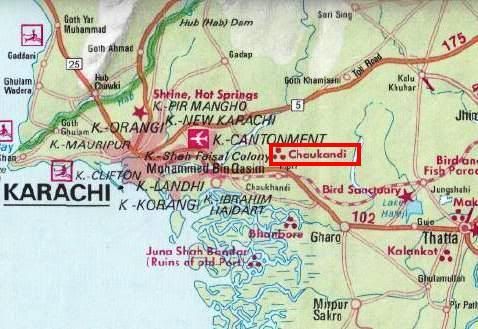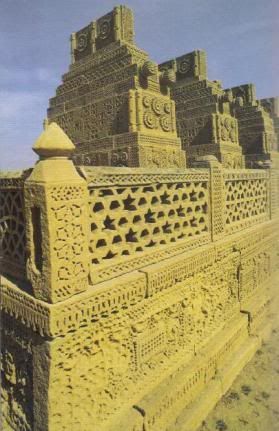This post is about the historic Chaukundi tombs located just outside Karachi. Before writing further I must admit that the last time I personally visited Chaukundi was in 1985 but I still vividly remember being fascinated by the stone carvings on these tombs. Following information comes from the tourist books and the Internet search. I’ve tried to include only the information which I could authenticate from multiple sources.

Since seeing is believing so lets start this post by watching the following video clip of Chaukundi tombs I found at the youtube.
If one travels out of Karachi on National Highway N5 – then between kilometer markers 26 and 27, towards the left side – lies an astonishing necropolis from several centuries ago called the Chaukundi Tombs.
Following map approximately shows the location of Chaukundi tombs on N5.

The word Chaukundi means ‘four-cornered’ and it got its name from the 5-star mausoleums of rich and influential people buried here and which are structurally supported by a column at each of its four sides. These columns usually support a dome or a canopy overhead the burial place. Hundreds of tombs stretch for nearly 3 kilometers. Another peculiar thing about these tombs is that they are all oriented in North-South direction.
Although a majority (of structures) consist of graves, there are some pavilion tombs supported by columns as well. Belonging to sixteenth century, the carving is similar to that found in the Samma Cluster at Makli necropolis. [source (3) below]
These tombs belong to Jokhio, Baloch and Burpat (or Burfat) tribes and most of them date back to between 13th and 17th centuries. The thing that makes these tombs stand out is the exquisitely-carved stone work. This stone work is unique to certain areas Sindh and Balochistan. Even though Chaukundi is the largest and most elaborately designed concentration of stone tombs in Pakistan, similar – but not so decorated tombs have been discovered all along the Makran coast and Lasbela in Balochistan and around River Indus delta in Sindh. In Sindh these sites include Malir, Dumlotee, Mirpur Sakro, Gujjo, Thariba, Sonda and Sehwan Sharif.
 The graves which belong to women have been decorated with stone carvings of flowers and jewelry which emphasizes the stature and wealth of the departed female. The graves of men have detailed stone carvings of horses, riders and weapons. Also included in the cluster of Chaukundi tombs are Muslim graves which tend to be unadorned.
The graves which belong to women have been decorated with stone carvings of flowers and jewelry which emphasizes the stature and wealth of the departed female. The graves of men have detailed stone carvings of horses, riders and weapons. Also included in the cluster of Chaukundi tombs are Muslim graves which tend to be unadorned.
The carving or motif which is most repeated on these tombs is a three-depth rosette which is most likely developed due to an early representation of the sun. Besides rosette, other carvings include the shapes of zigzags, flowers, crosses and diamonds.
There have been some reports of people stealing or defacing the stone carvings of these historic tombs. I’ve also heard recently that on weekend nights a local pir saayiN (Holy man) conducts services of removing ‘djinns’ from the psychologically disturbed people here. Hopefully both of these activities could be stopped from using Chaukundi tombs as their premises.
Chaukandi tombs is a protected site in the care of Department of Archaeology, Government of Pakistan.
References:
(1) Chaukhandi Tombs: Funerary Art in Sind and Balochistan, Oxford University Press 2003
(2) Insight Guide Pakistan – 2007
(3) Karachi -Illustrated City Guide by Yasmeen Lari – Oxford University Press 2000
(4) Spectrum Guide to Pakistan – 1998



















































@ms
How clever of you to spin the topic. We are talking about languages, specifically Hindi and Urdu, not countries. Why, then, you spun the topic to include other things, including religion?
Punjabi, for example, is spoken on both sides of the border and they originally had the same limitations in vocabulary. Urban Punjabis in Pakistan have overcome those vocabulary pitfalls but you will find the similar accent in rural areas.
Since you have mentioned, I’ve been to India and know the different accents spoken there. And I’ve noticed these things from the Punjab to Kerala. And aren’t we talking about Hindi in general, rather than other Indian languages?
Oh, and I forgot to add. Ghain (غ) is also absent in Hindi in its truest form. It is also absent in Punjabi.
Ghalati is being spoken as Galat for example.
You can look at Urdu vocabulary and see the dialogues spoken in Hindi and Urdu films to get the difference.
@shez
I love how you pakistanis try to understand India . Unfortunately the fact is it is VERY big – I understand its easier for you to see us a consistent uniformly distributed set of people but we are not- growing up in Delhi I can tell you that there were hundreds of accents from a hundred different cultures – from bengalis to tamils. If its easier for you to understand us then keep your misinformed views – but if you take the time to rise above the general belief of pakistanis of indians as vegetarian daal eating dark, uncultured non believers (not that there is ANYthing wrong with ANY of these) …you will find a lot things of interest.
Dawn has carried a photo feature on Makli necropolis today. Can be seen at:
http://www.dawn.com/2011/06/09/maklis-aura-revisit ed.html
Ayaz
Thanks for your comment. You are correct about the ‘pagri’ on top of some of the chaukundi tombs having Turkish origin. Tonight I read in a book called ‘Chaukhandi tombs in Pakistan’ by Syed Khurshid Hasan this paragraph:
and then following para linking it to Chaukundi tombs:
Sorry I forgot to mention one thing. The misfortune is how many people of Karachi took time out to see the wonderful piece of art. We should take our school kids out so they would appreciate their heritage.